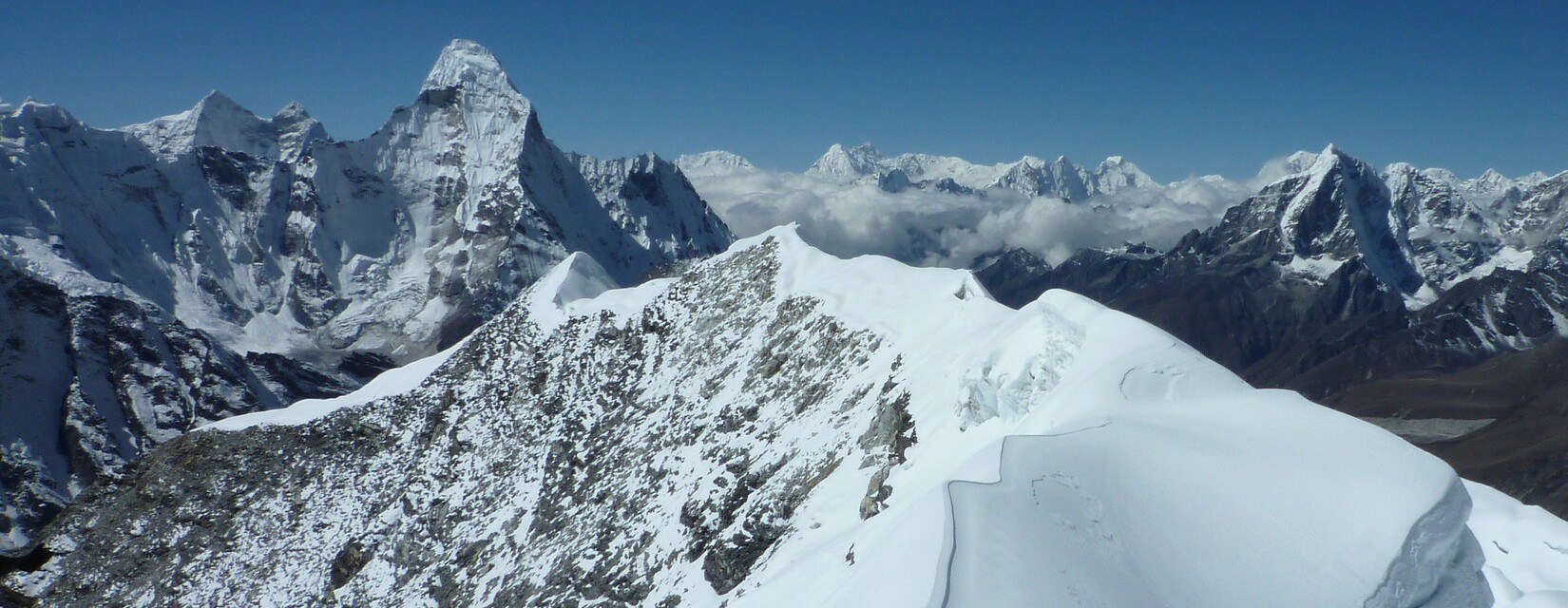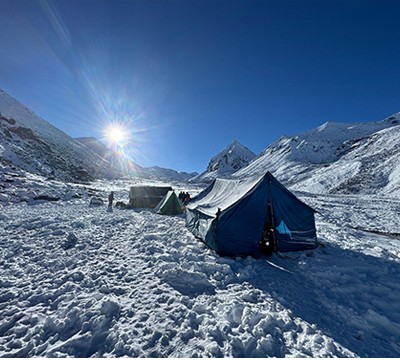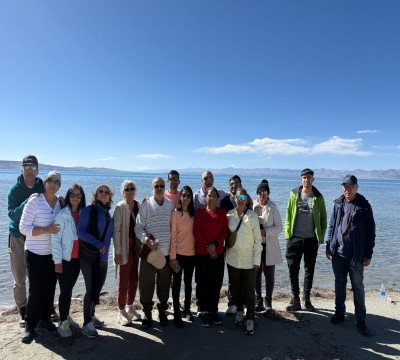Embark on a thrilling adventure with Himalayan Asia Treks and Expedition P Ltd as you compare two iconic Himalayan journeys: the Mera Peak Trek and the Island Peak Climbing expedition. In 2024, delve into the pristine beauty of the Mera region, trekking through enchanting forests, remote valleys, and stunning landscapes. In 2025, conquer the challenge of Island Peak, ascending through glaciers and steep ridges to reach its majestic summit. Then, in 2026, immerse yourself in both experiences, gaining a profound understanding of the Himalayas' diverse terrain and cultures. Whichever expedition you choose, Himalayan Asia Treks promises unforgettable memories and unparalleled adventure in the heart of the world's highest peaks.
Mera Peak Trek vs. Island Peak Climbing
Mera Peak and Island Peak are two of the most incredible climbing peaks globally. Both are the famous climbing peaks in Everest, Nepal. Mera Peak Climbing and Island Peak Climbing are extremely popular as the first choice of many novice climbing. A adventure traveler who has not researched well about climbing, in general, has a hard time picking one out of two peaks. The comparison parameters can be anything like Climbing Difficulty, Location, and physicality demand between Mera Peak and Island Peak.
Let’s dive deep into the facts that clarify which one to choose between Mera Peak and Island Peak (Imja Tse Peak) and the easier climb than the other.
Mera Peak and Island Peak Similarities
Even though you are here to find out what differences between Imja Tse Peak Climbing and Mera Peak Climbing, there are still many similarities that tie up both the peaks together.
- Both Mera and Island Peaks lie in the Mahalangur section of the Himalayas in Nepal and lie close to each other.
- Mera Peak stands at 6,461 meters, and Island Peak stands at 6,189 meters. It is a fairly close height.
- Both are climbing peaks that don’t need a hardcore mountaineering experience. It just requires a normal climbing experience to find it difficult to climb the peaks.
Mera Peak Climb vs. Island Peak Climbing | which one is an easier climb?
As already mentioned, Mera Peak and Island Peak do not require hardcore climbing experience. It is also why most beginner-level climbing choose these two peaks for a climb. Mera Peak is a comparatively easier climb than Imja Tse Peak.
Island Peak pushes you to climb through steep hills at higher and lower elevations. The steep ice climbs and the headwall challenges make Imja Tse Climb difficult. Regular icefalls, rocky ridge and risky glacial walk to the top make Island Peak Climbing a comparatively difficult climb than Mera Peak Climbing.
However, reaching Mera Peak Climb’s Base Camp is more difficult than reaching Island Peak Climb’s Base Camp. The ease points of Mera Peak Climb are better than that of Island Peak Climb. However, the feeling of climbing both the peaks is similar. You want to breathe in the Himalayas and test your physicality like never before. Both climbs provide you with that chance. Island Peak Climbing Package covers Everest Base Camp Trek also.
How hard are Island Peak Climb and Mera Peak Climb?
Answering how hard climbing Imja Tse Peak is quite different for different people. Climbing Imja Tse (Island Peak) tests your tolerance and physicality at its core. The footwall is like the big step and the toughest climbing part. The air gets thinner and thinner every time you get to a higher altitude. And it makes climbing Island Peak a tough thing to do. However, The Island peak’s climbing route is safer because of fixed lines.
In short, climbing Mera Peak Climbing doesn't require a hard technical climb compared to the Imja Tse. It is a straightforward climb with no steep hills like Island Peak. So, it gives Mera Peak an edge over the Imja Tse Peak (Island Peak).
Mera Peak Climb is easier than Imja Tse Peak (Island Peak) doesn’t mean that it is that easy anyone can complete it. Completing both peak climbs requires a sense of determination, hope, and hard work. You can’t just go out there and try summiting it. There should be a proper plan, preparation, and idea regarding climbing in general.
How to prepare for Mera Peak and Island Peak (Imja Tse Peak) Climb?
It doesn’t matter which climb is easier or tougher than the other. It would help focus on approaching the climbing idea and preparing for the long journey ahead. Preparing for Mera Peak and Imja Tse Peak (Island Peak) is similar, with only research and planning differences.
To prepare for both peak climbs following things need to be considered.
● Strong Mentality and Hope
No matter which tough journey you go on, the basic idea is to be mentally strong. It would be best to keep that in your head and always move forward. If there is no hope, there is no journey. Just like Stephen King said, “Remember hope is a good thing, maybe the best of things, and no good thing ever dies.” It’s exactly like that. The quote applies not only to the climbs but also to life’s journey.
● Go camping and hiking
While you are on Mera Peak or Island Peak (Imja Tse) Climb, it is a relatively higher altitude than where you are right now. It would help if you were a little familiar with walking so that it helps you in the long run. Go o hiking on weekends and find out your level of tolerance. It is hard to complete the Peak Climbs if you can’t even complete a hike. Exercising and walking is one good step to improve your stamina and physicality.
● Get used to climbing gear
No climb is complete with you using the climbing gear. There are many types of equipment in climbing gear. Climbing gear is mandatory if you want to complete the climb with little discomfort. And when you are going on the peak climbs, you need to be familiar with climbing gear, all for the safety of climbing.
Best Time to go on Island Peak Climb and Mera Peak Climb
As already mentioned, Imja Tse and Mera Peak lie close. It means both the peaks have similar kinds of climate and weather. The best time to go to both peaks in April, May, October, and November. The best part about the months is that you don't need to worry about extreme rainfall and snowfall. The trails don't get too slippery, and you will find it amazing to see the unobstructed views of the glorious Himalayas while exploring the trail.
Short Itinerary of Mera Peak Climbing with Everest Base Camp Trek
Day 01: Arrival in Kathmandu
Day 02: Kathmandu valley sightseeing
Day 03: Flight to Lukla and Climb to Puiyan (2800m.)
Day 04: Trek to Pangkongma (2,850m/6hours)
Day 05: Trek to Nigmsa (2745m. / 6hours)
Day 06: Trek to Chhatra Khola (3150m. / 6hours)
Day 07: Trek to Kothe (3600m. / 6hours)
Day 08: Trek to Tangnang (4,350m. / 6hours)
Day 09: Acclimatization Tangnang.
Day 10: Trek to Khare (5,045m. / 6hours)
Day 11: Trek to Mera Base Camp (5300m. / 6hours)
Day 12: Climb to Mera High Camp (5hours)
Day 13: Summit Mera Peak (6476m) and return back to Mera Peak Base Camp
Day 14: Trek to Tangnang
Day 15: Trek to Mousum Kharka (6hours)
Day 16: Trek to Thuli Kharka. (6hours)
Day 17: Trek to Lukla (6hours)
Day 18: Flight to Kathmandu.
Day 19: Leisure day in Kathmandu.
Day 20: Departure.
Short Itinerary Island Peak Climbing with Everest Base Camp Trek
Day 01: Arrival in Kathmandu, (1350m)
Day 02: Kathmandu: trip preparation (1,350m)
Day 03: Fly to Lukla then Trek to Phakding (2,800m/4 hours)
Day 04: Trek to Namche Bazaar (3,438m/6 hours)
Day 05: Namche Bazaar: Acclimatization Day (3,438m)
Day 06: Trek to Tengboche (3,870m/ hours)
Day 07: Trek to Pheriche (4,288m/ 6 hours)
Day 08: Trek to Lobuche (4,940m/6 hours)
Day 09: Trek to Gorak Shep, Hike to Everest Base Camp (5,364m/7 hours)
Day 10: Hike to Kala Patthar and back to Lobuche (5,545m/8 hours)
Day 11: Trek to Kongma La to Chhukung (4,730m/7 hours)
Day 12: Trek to Island Peak base camp (5,200m/4 hours)
Day 13: Pre-climb training on Island Peak Base Camp (5,200m)
Day 14: Island Peak base camp to Island Peak summit back to base camp (6,189m)
Day 15: Island Peak Base Camp to Pangboche (3,985m/6 hours)
Day 16: Trek to Namche Bazaar (3,438m/5 hours)
Day 17: Trek to Lukla (2,800m/7 hours)
Day 18: Fly to Kathmandu (1,350m)
Day 19: Leisure day.
Day 20: Final Departure
Mera Peak vs. Island Peak | The Conclusion
Mera Peak is an easier climb than Island Peak. However, from an adventure point of view Island Peak tests your skills and toughness altogether. If you are a beginner-level climbing, Mera Peak is the best for you. But, if you like taking challenges and want to do experiments while summiting, Island Peak is the ideal climb for you.



